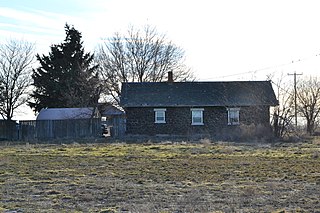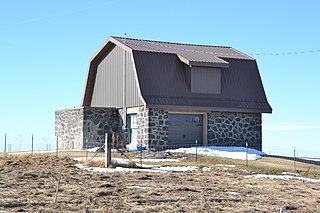William Cook House may refer to:

Howell Trevor Pugh, known as H. T. Pugh, was a stonemason who was trained in Wales and worked primarily in Jerome, Idaho. His high quality work popularized the use of lava rock in the Jerome area, eventually including for fine residences in town. More than 20 of his works are preserved and are listed on the National Register of Historic Places.

The James Bothwell Water Tank House is a water tank house located on a farm 3.25 miles (5.23 km) north of Jerome, Idaho. The building was constructed circa 1926 for James Bothwell, a local lawyer and farmland investor. Bothwell built the tank house and a well on the property to help provide water for the farm. The building was constructed with lava rock by stonemason John Gott, who was trained in Germany. It is one of two original rock water tank houses remaining in Jerome and Lincoln Counties.

The Frank J. Brick House is a house located at 300 N. Fillmore St. in Jerome, Idaho. It was built by stonemason H.T. Pugh in 1917. The lava rock house is topped by a gable roof with four purlins and a dormer on the south side. The house was one of the first lava rock residences constructed in Jerome.

The Canyonside School is a schoolhouse located 4 miles (6.4 km) south of Jerome, Idaho, USA. The lava rock building was constructed by the stonemason H.T. Pugh in 1920; it was one of four stone rural schools built by him. The school replaced several wooden school buildings in the area and was considered a sign of the region's agricultural prosperity, as farming in the area was profitable enough to sustain long-term investments in its educational infrastructure. The building is now a private home.

The Jerome City Pump House is a water works building located near Jerome, Idaho that was built in 1922 by stonemason H.T. Pugh. It was listed on the National Register of Historic Places in 1983.
The George Lawshe well house is a building located in Jerome, Idaho, United States, listed on the National Register of Historic Places.
The Lulu Graves Farm is a farm located in Jerome, Idaho, United States, listed on the National Register of Historic Places. The 5-acre (2.0 ha) farm includes a house, poultry house, and cattle loafing shed, all of which were built with local lava rock. Lava rock was a popular building material in south central Idaho in the late nineteenth and early twentieth centuries, and many lava rock buildings still survive in the area. The bungalow-style farmhouse was built in 1929 or 1930 by local stonemason H.T. Pugh.

The Merritt Fry Farm is a historic farm located west of Jerome, Idaho, United States. The farm includes three stone buildings: a house, a bunkhouse, and a barn. The house and bunkhouse were built by prominent Jerome stone mason H. T. Pugh and illustrate his ability to match stones, join them with mortar, and use concrete for decoration. Farmer Merritt Fry had the bunkhouse built in 1916; it served as his temporary home until he could build a more permanent house. While farmers frequently built temporary farmhouses, Fry's is unusual in that it uses stone rather than a less sturdy material. The barn followed the bunkhouse in 1926, and Fry's permanent farmhouse was completed in 1930.
The Edward M. Gregg Farm is a historic farm located near Jerome, Idaho. The property includes a farmhouse, bunk house, well house, barn, and chicken house. The buildings were built with lava rock, a popular building material in south central Idaho in the late nineteenth and early twentieth centuries. The one-story house was built in 1914 for Edward M. Gregg, and the remaining buildings were added over the next two decades. The early 1930s well house was designed by local stonemason H.T. Pugh.
The Jessie Osborne House is a house near Jerome, Idaho that was listed on the National Register of Historic Places in 1983. It is an example of the simple rectangular gable-roofed houses built on farms in this area of Idaho. It is unique in that it has not been changed, added on to or enlarged. It was built by master stonemason H.T. Pugh and by Paul Kartsky.

The George V. Doughty House and Garage are a historic house and garage located northeast of Jerome, Idaho, United States. The lava rock buildings were constructed in 1914 by stonemason H. T. Pugh for farmer George V. Doughty. The house's design includes a Colonial Revival style hipped roof and a bungalow style front porch.

Ignacio Ygnatil Berriochoa was a skilled stonemason in Lincoln County, Idaho. He was born in the Basque region of Spain and moved to Idaho in 1904. He lived in Shoshone, Idaho from 1910 to 1949 where he was a farmer and sheepman. A number of his works are listed on the U.S. National Register of Historic Places.
William Lindsey Darrah was a sheep rancher and stonemason in Shoshone, Idaho known for his construction of lava rock water tanks from the 1910s to 1920s. He built water tanks ranging from approximately eight to 30 feet high and from 12 to 25 feet in diameter. His tanks were typically built with a stone foundation several feet into the ground. The walls were approximately three feet wide and built out of lava stones and lime mortar. Darrah's tanks were typically accompanied by one-story pump houses
The Ben Darrah Water Tank and Well House near Shoshone, Idaho, United States, were built in c. 1916 by stonemason Bill Darrah. They were listed on the National Register of Historic Places in 1983; the listing included two contributing buildings on 1.3 acres (0.53 ha).
The G. H. Erdman House is a historic house located 4.5 miles (7.2 km) west of Jerome, Idaho. The house was constructed circa 1920 for farmer G. H. Erdman. Local stonemasons the Otis Brothers constructed the lava rock home. The home's design includes a clipped gable roof, shiplap within the gables, decoratively arranged panes of glass in the front windows, and a fruit cellar in the back of the building.

The Heuer Well House/Water Tank, located northeast of Jerome, Idaho, is a lava rock house with joined water tank which was built in 1929 by stonemason H.T. Pugh and Ed Bennett. It was listed on the National Register of Historic Places in 1983.
The Ben Laughlin Water Tank House-Garage, near Jerome, Idaho, was built in 1927. It was listed on the National Register of Historic Places in 1983.

The William Weigle House and Water Tank, near Jerome, Idaho, is a lava rock structure built in 1919. It was listed on the National Register of Historic Places in 1983.













